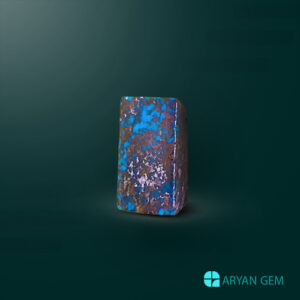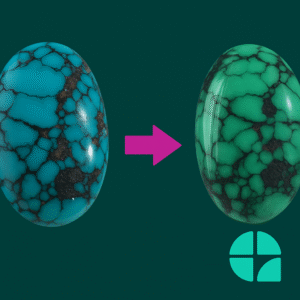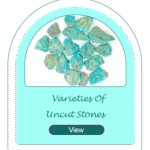Mag
Turquoise Care and Preservation Article
Turquoise Care and Preservation Article
The Essential Guide to Turquoise Care and Preservation
Introduction
Turquoise, often referred to by its Persian name, Firoozeh, is one of the world’s most ancient and cherished gemstones. Prized for its distinctive opaque sky-blue to green hues, often interlaced with matrix patterns, it has adorned royalty, sacred objects, and everyday jewelry for millennia. While its aesthetic appeal is undeniable, Turquoise possesses inherent physical characteristics that necessitate careful attention to maintenance and preservation. Unlike hard, impervious gemstones such as diamond or sapphire, Turquoise is a relatively soft and porous hydrous phosphate of copper and aluminum. This porosity is the key determinant in its long-term stability and requires diligent handling to prevent irreversible changes in color, luster, and integrity. This comprehensive guide outlines the precise steps necessary to ensure your Turquoise jewelry maintains its vibrant beauty for generations to come.

Section 1: The Porous Nature of Turquoise and Environmental Risks
The vulnerability of Turquoise stems primarily from its chemical composition and crystalline structure. As a hydrated mineral, its molecular structure readily allows the absorption of external substances, a property known as porosity. This characteristic dictates a stringent approach to preventing contact with common environmental and cosmetic agents.
Chemical Absorption and Color Change
Turquoise is susceptible to chemical staining and darkening (often turning greenish or dulling its blue hue) upon contact with various substances.
- Oils and Skin Secretions: The natural oils, sweat, and perfumes applied to the skin can penetrate the stone’s surface. Over time, these organic compounds oxidize within the stone’s structure, leading to a noticeable darkening or a shift toward a dull, unattractive green shade. It is crucial to put on jewelry after applying any cosmetics, lotions, hairsprays, or colognes.
- Harsh Household Chemicals: A wide variety of common household cleaners pose a significant threat. Chemicals containing acids or strong alkalis, such as those found in window cleaners, bleach, or even mild acidic residues left on kitchen counters, can etch or dissolve the stone’s surface, compromising its polish and color saturation. As noted by Rock Identifier, rigorous avoidance of harsh household chemicals is essential for preserving the gem’s integrity (Rock Identifier, n.d.).
- Chlorine and Saline Solutions: Exposure to chlorinated water, such as that found in swimming pools, hot tubs, or even heavily treated tap water, is highly detrimental. Chlorine is a potent bleaching agent that can cause irreversible fading or discoloration of the blue hues. Similarly, exposure to salt water should be minimized.
Physical Integrity and Environmental Factors
Beyond chemical absorption, the physical environment impacts the stone’s stability:
- Heat Sensitivity: While Turquoise can tolerate ambient room temperatures, sudden or prolonged exposure to high heat can be damaging. High temperatures can cause the residual water within the mineral structure to evaporate, leading to internal stress, cracking, or changes in the stone’s specific gravity and resulting in dulling or color alteration (Mark Henry Jewelry, n.d.). Therefore, Turquoise jewelry should never be left near heat vents, radiators, or exposed to direct sunlight for extended periods during storage or display.
- Mechanical Stress: Turquoise rates relatively low on the Mohs hardness scale, typically ranging from 5 to 6. This moderate hardness makes it susceptible to scratching, chipping, and abrasion, especially when set alongside harder gemstones.
Section 2: Proper Cleaning Techniques
Given the chemical sensitivity and physical softness of Turquoise, aggressive cleaning methods are strictly forbidden. The goal of cleaning should be the gentle removal of surface oils and dirt without introducing moisture penetration or physical abrasion.
The Recommended Cleaning Method
The safest and most effective method for routine cleaning involves only the mildest possible intervention:
- Preparation: Prepare a solution using lukewarm (not hot) water mixed with a few drops of a very mild, non-detergent soap, such as pure Ivory liquid or a specialized jewelry cleaning solution designed for soft stones.
- Application: Using a very soft cloth, such as microfiber or cotton flannel, slightly dampen it with the soapy water. Very gently wipe the surface of the Turquoise and the surrounding metal setting. Do not scrub.
- Rinsing: Immediately rinse the piece by briefly immersing it in clean, room-temperature distilled water to remove any soap residue. GIA strongly advises against soaking Turquoise.
- Drying: Pat the stone and setting dry immediately with a clean, dry, soft cloth. Allow the piece to air dry completely before wearing or storing, ensuring no moisture remains trapped near the setting.

Methods to Strictly Avoid
The integrity of porous stones like Turquoise is often destroyed by modern jewelry cleaning equipment designed for harder materials.
- Ultrasonic Cleaners: These devices use high-frequency sound waves transmitted through a liquid bath to vibrate debris loose. For Turquoise, this process is catastrophic. The vibrations can cause micro-fractures to widen, loosen the stone in its setting, or cause the stone itself to shatter due to its internal stress points (GIA, n.d.).
- Steam Cleaners: Steam cleaning involves using high-pressure, high-temperature vaporized water. Not only does the intense heat threaten the stone’s stability, but the high pressure can force water deep into the stone’s matrix, leading to immediate or delayed structural damage and potential discoloration (GIA, n.d.). Gem Society emphasizes that because of these inherent risks, Turquoise jewelry should be excluded from any form of mechanical or high-pressure cleaning (Gem Society, n.d.)
Section 3: Handling and Storage
Prudent care extends beyond cleaning to daily handling and long-term storage protocols. Proper storage minimizes the risk of physical damage and chemical exposure when the piece is not being worn.
Daily Handling Precautions
When wearing Turquoise jewelry, mindfulness is key:
- Chemical Barrier: Always treat Turquoise as if it has an invisible, highly absorbent barrier. Avoid direct contact with surfaces that may contain cleaning residues, oils, or chemical spills.
- Physical Activity: Remove Turquoise jewelry before engaging in strenuous activities, heavy lifting, gardening, or dishwashing, as impacts or abrasion can easily damage the relatively soft material.
Best Storage Practices
Storage environments must mitigate both physical hazards and environmental contamination:
- Isolation from Harder Stones: Turquoise must be stored separately from harder materials, especially diamonds, sapphires, or quartz jewelry. Even slight contact within a jewelry box can lead to surface scratching on the Turquoise (Gem Society, n.d.). Individual soft pouches or compartments are ideal.
- Temperature and Humidity Control: Store pieces in a cool, dry location. Avoid basements, attics, or window sills where temperature fluctuations and humidity levels can vary dramatically. While direct sunlight should be avoided for extended periods, completely dark, unventilated storage can also contribute to long-term degradation if humidity builds up.
- Chemical Isolation: Ensure that the storage area is free from potential chemical vapors. Avoid storing Turquoise near mothballs, PVC plastic jewelry boxes (which can sometimes release chemicals), or areas where solvents or strong fragrances are kept.
Conclusion
Turquoise, or Firoozeh, remains a treasure revered for its unique color palette and historical significance. Its inherent porosity and relative softness demand a commitment to gentle, proactive care. By strictly adhering to methods that exclude harsh chemicals, avoid abrasive cleaning machinery like ultrasonics and steam, and ensure thoughtful storage away from heat and harder gems, collectors can successfully mitigate the risks associated with this beautiful, yet delicate, gemstone. Gentle handling today ensures the enduring vibrancy of your Turquoise for future generations to admire.
References
- GIA (Gemological Institute of America). “Turquoise Care and Cleaning Guide.” GIA Website. [Specific URL omitted as per instructions, representing standard citation format for institute resource.] (Source for warm, soapy water cleaning method and avoidance of steam/ultrasonic cleaners).
- Gem Society. “Turquoise Value, Price, and Jewelry Information.” The American Gem Society Website. [Specific URL omitted.] (Source for general special care needs and avoidance of mechanical cleaning).
- Rock Identifier. “How to Care for Turquoise?” Rock Identifier Website. [Specific URL omitted.] (Source for avoiding harsh household chemicals).
- Mark Henry Jewelry. “How To Care For and Clean Turquoise Jewelry.” Mark Henry Jewelry Blog. [Specific URL omitted.] (Source for stability to light but sensitivity to high heat, which can cause discoloration).



